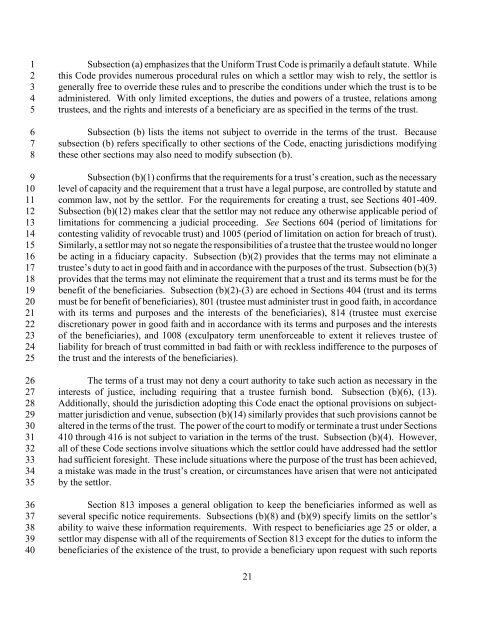uniform trust code - Kansas Judicial Branch
uniform trust code - Kansas Judicial Branch
uniform trust code - Kansas Judicial Branch
Create successful ePaper yourself
Turn your PDF publications into a flip-book with our unique Google optimized e-Paper software.
1<br />
2<br />
3<br />
4<br />
5<br />
6<br />
7<br />
8<br />
9<br />
10<br />
11<br />
12<br />
13<br />
14<br />
15<br />
16<br />
17<br />
18<br />
19<br />
20<br />
21<br />
22<br />
23<br />
24<br />
25<br />
26<br />
27<br />
28<br />
29<br />
30<br />
31<br />
32<br />
33<br />
34<br />
35<br />
36<br />
37<br />
38<br />
39<br />
40<br />
Subsection (a) emphasizes that the Uniform Trust Code is primarily a default statute. While<br />
this Code provides numerous procedural rules on which a settlor may wish to rely, the settlor is<br />
generally free to override these rules and to prescribe the conditions under which the <strong>trust</strong> is to be<br />
administered. With only limited exceptions, the duties and powers of a <strong>trust</strong>ee, relations among<br />
<strong>trust</strong>ees, and the rights and interests of a beneficiary are as specified in the terms of the <strong>trust</strong>.<br />
Subsection (b) lists the items not subject to override in the terms of the <strong>trust</strong>. Because<br />
subsection (b) refers specifically to other sections of the Code, enacting jurisdictions modifying<br />
these other sections may also need to modify subsection (b).<br />
Subsection (b)(1) confirms that the requirements for a <strong>trust</strong>’s creation, such as the necessary<br />
level of capacity and the requirement that a <strong>trust</strong> have a legal purpose, are controlled by statute and<br />
common law, not by the settlor. For the requirements for creating a <strong>trust</strong>, see Sections 401-409.<br />
Subsection (b)(12) makes clear that the settlor may not reduce any otherwise applicable period of<br />
limitations for commencing a judicial proceeding. See Sections 604 (period of limitations for<br />
contesting validity of revocable <strong>trust</strong>) and 1005 (period of limitation on action for breach of <strong>trust</strong>).<br />
Similarly, a settlor may not so negate the responsibilities of a <strong>trust</strong>ee that the <strong>trust</strong>ee would no longer<br />
be acting in a fiduciary capacity. Subsection (b)(2) provides that the terms may not eliminate a<br />
<strong>trust</strong>ee’s duty to act in good faith and in accordance with the purposes of the <strong>trust</strong>. Subsection (b)(3)<br />
provides that the terms may not eliminate the requirement that a <strong>trust</strong> and its terms must be for the<br />
benefit of the beneficiaries. Subsection (b)(2)-(3) are echoed in Sections 404 (<strong>trust</strong> and its terms<br />
must be for benefit of beneficiaries), 801 (<strong>trust</strong>ee must administer <strong>trust</strong> in good faith, in accordance<br />
with its terms and purposes and the interests of the beneficiaries), 814 (<strong>trust</strong>ee must exercise<br />
discretionary power in good faith and in accordance with its terms and purposes and the interests<br />
of the beneficiaries), and 1008 (exculpatory term unenforceable to extent it relieves <strong>trust</strong>ee of<br />
liability for breach of <strong>trust</strong> committed in bad faith or with reckless indifference to the purposes of<br />
the <strong>trust</strong> and the interests of the beneficiaries).<br />
The terms of a <strong>trust</strong> may not deny a court authority to take such action as necessary in the<br />
interests of justice, including requiring that a <strong>trust</strong>ee furnish bond. Subsection (b)(6), (13).<br />
Additionally, should the jurisdiction adopting this Code enact the optional provisions on subjectmatter<br />
jurisdiction and venue, subsection (b)(14) similarly provides that such provisions cannot be<br />
altered in the terms of the <strong>trust</strong>. The power of the court to modify or terminate a <strong>trust</strong> under Sections<br />
410 through 416 is not subject to variation in the terms of the <strong>trust</strong>. Subsection (b)(4). However,<br />
all of these Code sections involve situations which the settlor could have addressed had the settlor<br />
had sufficient foresight. These include situations where the purpose of the <strong>trust</strong> has been achieved,<br />
a mistake was made in the <strong>trust</strong>’s creation, or circumstances have arisen that were not anticipated<br />
by the settlor.<br />
Section 813 imposes a general obligation to keep the beneficiaries informed as well as<br />
several specific notice requirements. Subsections (b)(8) and (b)(9) specify limits on the settlor’s<br />
ability to waive these information requirements. With respect to beneficiaries age 25 or older, a<br />
settlor may dispense with all of the requirements of Section 813 except for the duties to inform the<br />
beneficiaries of the existence of the <strong>trust</strong>, to provide a beneficiary upon request with such reports<br />
21

















